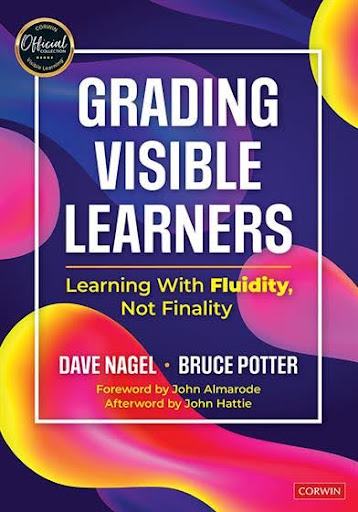GRADING GRE4T Learners
Our Approach to Grading Actions
Grading Actions Must Align With Research
Grading practices often misalign with research and vary significantly between classrooms, sending mixed messages to students. While they are encouraged to be curious and take risks, the grading system frequently rewards compliance and completion, punishing those who stray from predetermined paths. This creates a frustrating environment where students must continually adapt to new grading expectations, sometimes even within the same day. Such inconsistency undermines teachers’ efforts to provide meaningful instruction and assessment, hindering their ability to positively impact student learning and development. Ultimately, a more coherent and supportive grading system is needed to align with educational goals and foster student engagement.
Are grades undesired carrots? Too often grades are the carrot intended to motivate students. We hear often that what used to motivate students doesn’t anymore. Well, we believe it never really did, it was a game that fewer students in 2025 are interested in playing. In classrooms where grades are emphasized, students tend to attribute performance to ability rather than effort (Ames, 1992). Therefore, using grades as a carrot to promote effort may defeat the purpose (Guskey, 2019)!

Grading GRE4T Learners Framework

Grading practices must strategically cultivate resilience, teamwork, self-regulation, and motivation in students. To promote resilience, educators should emphasize improvement, allowing setbacks to be viewed as growth opportunities through revisions. Teamwork is enhanced with collaborative projects and group assessments that encourage peer feedback. Self-regulation is supported by clear grading criteria and goal setting, helping students track their progress. Motivation increases by recognizing achievements and setting personalized goals, linking efforts to outcomes. Aligning grading with these traits fosters a positive learning environment that empowers students.
GRE4T Learner Model

Grades as Effective Feedback
Professional Development for Grading GRE4T Learners
Transform your grading and assessment practices into powerful tools for student success When we implement a grading system that prioritizes completion and compliance and penalizes students who take risks, we disrupt the learning journey—not further it. It’s time to align how we grade with what we know from research works best and help move learning forward for all students.
Core Grading Actions of Schools Developing GRE4T Learners
| Core Action | Description |
|---|---|
| Teacher Collaboration | PLC teams cultivate collaborative expertise and focus ongoing dialogue on grading actions. We don’t mean sitting with colleagues grading papers! Instead they focus dialogue on topics such as assignment analysis, agreement on success criteria expected for mastery, failure prevention and intervention strategies, accurate weighing of student work evidence towards how grades are determined, etc. |
| Clarity of Scoring | A crucial yet often overlooked consideration for teachers and PLCs is the alignment of student work with established success criteria and task rigor. Educators play a key role in defining how student projects and evidence are produced, ensuring that these expectations are communicated clearly to students. This upfront clarity helps learners understand how to interpret feedback and grades effectively, enhancing their ability to engage with the learning process. |
| Collaborative Scoring and Collaborative Feedback | Teachers routinely collaboratively score and grade student work and products with common understanding of criteria. Teachers also share and discuss what feedback would be most impactful to move students’ learning forward. |
| Multiple Opportunities for Success and Mastery Through the Use of Stipulated Second Chances: | Teachers and collaborative teams provide students with multiple opportunities for success and mastery, accompanied by stipulations such as additional work or time commitments. These requirements are designed to help students cultivate effective learning habits without devaluing their overall grades through point reductions. |
SI2TE Model Framework for Developing Gre4T Learners

| Element | Brief Description |
|---|---|
| Support | Students must feel supported in taking risks in their learning leading to confidence they can overcome challenges they face in their learning journey. |
| Intervention | Teachers and collaborative teams do not wait when they notice student(s) struggling in their learning. Systems are in place both at the school and classroom levels to be decisive in instructional moves and approaches to intervene and adjust to student learning needs. |
| Incentive | Teachers develop systems of actions to incentivize students towards achievement and desired behaviors vs. a system of consequences. This is different from rewards in that adult actions focus on deepening student motivation for a fuller understanding of topics and content. |
| T-I-M-E | Teachers and collaborative teams always view time as the variable and learning as the constant. Progress and growth are always primary drivers vs. focusing on achievement goals that their merit is based primarily in how fast they were reached! |
| Evidence | Teachers and collaborative teams are relentless in their pursuit of supporting students in their next steps of learning. This requires making adjustments in assessment strategies and tools to ensure the best and most accurate evidence of student learning is the focus of student work and performance expectations. |
Generative Learning Experiences and Clarity of Scoring Guide
In our new book Grading Visible Learners: Learning with Fluidity Not Finality (Corwin, 2025) we developed a Clarity of Grading Scoring Guide (CGSG), see Figure X. This instrument incorporates elements of this framework to help teachers align instruction with students’ learning stage and to allow more honest and efficacious feedback in the form of the students grade related to a progression of tasks that increase in cognitive complexity.
Holistic CLARITY OF GRADING SCORING GUIDE (CGSG)



